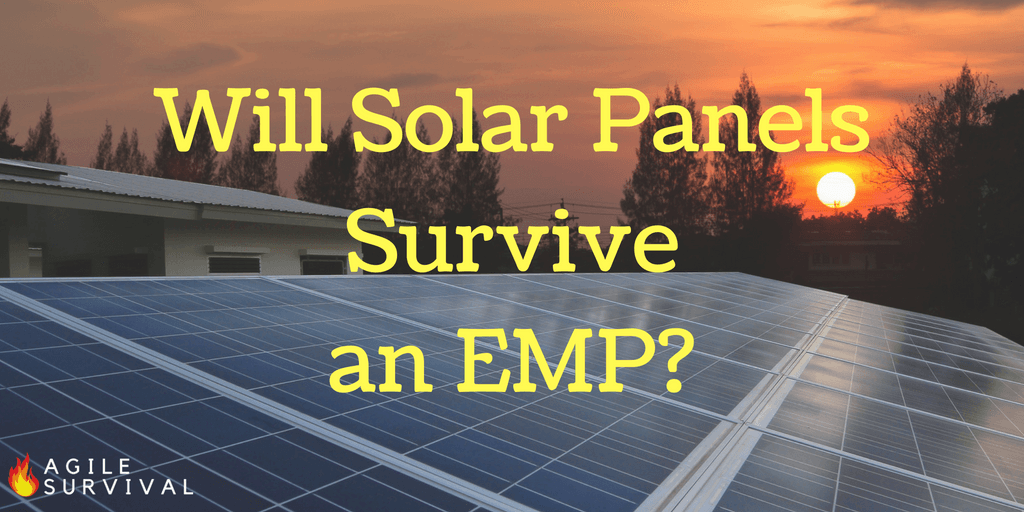
Solar power is hot these days. Whether you are living on the grid or off the grid. It's reliable compared to other options such as wind power.
Plus, it's getting cheaper every day.
But, how certain can you be that your solar panels will survive and EMP? The truth is, these systems can be vulnerable to an EMP attack.
The national power grid could be destroyed. Taking your system with it. But, solar panels will survive and EMP if you take the right precautions.
What is an EMP?
An EMP or Electro Magnetic Pulse generates a surge of charged particles. That surge creates a burst of electromagnetic energy - overwhelming and destroying wiring and microchips.
It can be the result of many things:
- solar flares
- nearby lightning strikes
- a secondary result of a nuclear detonation
- or can be deployed as a primary weapon
Here is a quick overview of how an EMP works:
Countries have developed such weapons because they leave an area's infrastructure and population untouched. But, they destroy any electronic equipment with a microchip.
This means everything from automobiles to computers. Even radio equipment and small electronics. Batteries should be safe. Depending on the source and magnitude, the EMP may or may not effect electronics.
A solar flare, for instance, could overload and destroy the national grid. But it would not be powerful enough to overwhelm electronic devices.
The only way to prevent an EMP from destroying electronic equipment is to seal it in a faraday cage. Also known as "hardening."
In 2004 and 2008, Congress commissioned studies to determine likelihood of an EMP attack. According to the report, "instead of destroying a city or a military base, [terrorists] may gain the greatest political-military utility from one or a few such weapons by using them—or threatening their use—in an EMP attack".
The report also states, China and Russia have both considered using EMPs an option. The military has prepared for this scenario by developing:
- hardened electronics
- vehicles that can resist EMPs
- hardened computers
- hardened solar power systems
You can't just store solar panels in a faraday cage. They must be outside. Exposed to sunlight.
So how do you protect them? First you need to understand how the EMP damages your solar panels.
How Are Solar Power Systems Affected?
Solar panel systems depend on several high-tech electronic components. As a result, they have some vulnerabilities.
Wires and antennae would pick up the energy surge from an EMP. Sensitive components connected to those wires and antennae would then be vulnerable.
The solar panels themselves are immune to high voltage surges. They don't contain any wires or antennae top pick up the EMP's energy. And, they don't have any sensitive electronic components inside.
However, most solar panels use of diodes to control current flow. Diodes are semiconductors, which can be damaged if not protected by surge suppressors.
The inverter and charge controller are also vulnerable to sudden spikes of energy.
It is difficult to protect your solar array's diodes, inverter and charge controller. You can't just box up the entire system in a faraday cage.
Your panels need a clear line of sight to the sky. And each component connects to all the others... through wires.
So how do you protect your system? Energy independence is important now. Imagine how important it would be if an EMP fried the nations electric grid. Well, You have a few options.
Potential Solutions
Backup/Replacement Equipment
Buy duplicates of all the necessary components of your solar power system. Store those components in a faraday cage, and have them readily available.
This is the most reliable option. It also has other benefits.
Should your system go down for any reason you can quickly repair or replace any failed components. Even in a non-emergency situation this would be useful. Such as a lightning strike. Or some element of your solar power system breaking.
The drawback to this plan is, of course, the cost involved.
High-quality solar equipment is not cheap. Having extra replacement parts could cost several hundred to several thousands dollars.
You also have the cost of building and storing the faraday cage. Compared to the components themselves, this isn't a major cost. But, it does need to be considered.
Additionally, the cost of solar panel systems has been decreasing rapidly year-after-year. So this may be a great option after-all. Especially if you can pick up discounted replacement parts.
Knowing you can just swap out any part that gets fried makes it the most reliable option. And it's good peace of mind.
EMP Hardened Systems
Another solution is to purchase a hardened solar power system.
A number of companies sell these systems, which are based on military designs.
They use charge suppressors on the wiring and internal hardening for the other components.
The advantage is that you can use it day-to-day. You won't have to worry about an unexpected EMP event destroying your equipment.
Ultimately, a hardened system has been specifically designed to withstand an EMP. It may be the best choice to maintain power after a catastrophic grid failure.
Compared to purchasing redundant components, hardened systems are:
- cheaper
- You don't have to worry about keeping them permanently sealed in EMP-protected boxes.
- And a hardened system ensures uninterrupted power during an emergency.
The redundant parts option is more flexible and reliable. You're covered if your system break down for any reason. You have replacements for every part.
More Information
The full report about EMP risks to the United States is at www.empcommission.org.
To learn more about the potential results of an EMP attack, check out this video. It explains a lot of EMP basics, and also dispels certain EMP myths.
Read Disaster Preparedness for EMP Attacks and Solar Storms to expand your EMP knowledge. And help you prepare for the potential risks of an EMP attack or solar storm.
